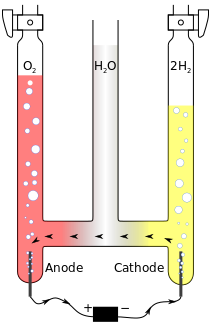|
电解 电解(electrolysis)是指将電流通过电解质溶液或熔融态物质,而在阴極和阳极上引起氧化还原反应的过程。电化学电池在接受外加电压(即充电過程)时,會发生电解过程。 舉例   以下為在酸性水溶液中電解水的例子。
總反應式 在這個反應中,陽極產生放出電子的反應(氧化),陰極產生取得電子的反應(還原)。 歷史電解的英文electrolysis是由希臘文ἤλεκτρον[ɛ̌ːlektron]「琥珀」和λύσις [lýsis] 「溶解」而來。
应用电解可用来进行各种电化学的制备和生产,是重要的工业过程。
法拉第定律法拉第第一電解定律電解過程中,在電極發生化學反應而產生的物質的質量與通過電解質的電量成正比。
法拉第第二電解定律當相同電量通過不同電解質時,沉積在電極的元素的摩尔數與它的離子所帶的電荷大小成反比。 参見參考資料
外部連結 |
Index:
pl ar de en es fr it arz nl ja pt ceb sv uk vi war zh ru af ast az bg zh-min-nan bn be ca cs cy da et el eo eu fa gl ko hi hr id he ka la lv lt hu mk ms min no nn ce uz kk ro simple sk sl sr sh fi ta tt th tg azb tr ur zh-yue hy my ace als am an hyw ban bjn map-bms ba be-tarask bcl bpy bar bs br cv nv eml hif fo fy ga gd gu hak ha hsb io ig ilo ia ie os is jv kn ht ku ckb ky mrj lb lij li lmo mai mg ml zh-classical mr xmf mzn cdo mn nap new ne frr oc mhr or as pa pnb ps pms nds crh qu sa sah sco sq scn si sd szl su sw tl shn te bug vec vo wa wuu yi yo diq bat-smg zu lad kbd ang smn ab roa-rup frp arc gn av ay bh bi bo bxr cbk-zam co za dag ary se pdc dv dsb myv ext fur gv gag inh ki glk gan guw xal haw rw kbp pam csb kw km kv koi kg gom ks gcr lo lbe ltg lez nia ln jbo lg mt mi tw mwl mdf mnw nqo fj nah na nds-nl nrm nov om pi pag pap pfl pcd krc kaa ksh rm rue sm sat sc trv stq nso sn cu so srn kab roa-tara tet tpi to chr tum tk tyv udm ug vep fiu-vro vls wo xh zea ty ak bm ch ny ee ff got iu ik kl mad cr pih ami pwn pnt dz rmy rn sg st tn ss ti din chy ts kcg ve


